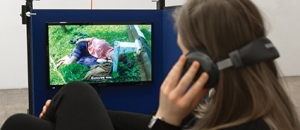Exhibition ‘The Border’ without Borders
Review
Where does Europe end and Asia begin? What influence do the borders have and who draws them? These are the key questions posed by art project ‘The Border,’ which spans many years and is being staged by the Goethe-Institut in conjunction with numerous partner institutions in 2017/2018. Having toured the cities of Moscow, St. Petersburg, Krasnoyarsk and Kiev, the exhibition is now being shown at the Georgian National Museum (GNM) Tbilisi History Museum (Karvasla). The opening took place on August 30.
‘The Border’ explores and reflects upon all manner of borders and their demarcation: as a mark of territorial inclusion or exclusion, as cultural, personal or social dividing lines, as an instrument we use to differentiate and distinguish between ‘us’ and ‘them’ or, indeed, to generate this dichotomy through borders in the first place.’ “Border” should be understood as a metaphor, as a figure which is not static, but rather the subject of agreements and change - an extremely relevant topic for Russia and the former Soviet republics, as well as for Germany and Europe in equal measure. Thus, the geographical and cultural border between Europe and Asia is the topical thread running through the exhibition. The project approaches this subject matter from an artistic angle and channels our view beyond purely political or economic concerns to take in a cultural dimension. The aim is to promote a differentiated engagement with the processes involved in, the motivations behind and the causes leading to the drawing of borders.
“The exhibition is being held within the framework of the Georgia-Germany year [to mark the 25th anniversary since the establishment of diplomatic relations], said Mikheil Tsereteli, Deputy Director General of GNM. “It is one of the most important events of the second part of the year”.
“There will be around 50 events in total within the scope of Georgian-German year,” said H.E. Ms. Heike Peitsch, Ambassador of Germany to Georgia. “We want to show the diversity; to look at the relevant topics from a new perspective. There are often talks as to whether Georgia belongs to Europe or not. When the German Minister of Foreign Affairs opened the Georgian-German year in April in Berlin, he noted that Europe is anywhere where the government and people recognize western values such as democracy, human rights, and the rule of law. Georgia belongs to Europe, because the Georgian people do share these values. The polls showed that 80% of the Georgian population acknowledges western values. Since Georgia regained its independence, Germany has supported Georgia in all spheres and this year, we celebrate the 200th year since the arrival of the first German colonists to Georgia”.
The exhibition focuses upon a younger generation of artists who will be showing their insight into and reflections on the topic for the first time together in a travelling exhibition. Around 24 works (photos, videos, installations, objects) of over 30 artists from Georgia, Germany, Ukraine, Belarus, Armenia, Azerbaijan, Kirgizstan, Kazakhstan, Uzbekistan, Russia and Tajikistan are exhibited.
“This is my first official occasion in Georgia,” Barbara Von Munchausen, the new director of the Goethe Institute, stated. “We plan to arrange a dialogue between Georgian and German artists with the aim of deepening Georgians’ knowledge of German art”.
‘Mugham Karaoke’ is one of the projects, which connects the ancient musical Azeri style Mugham and contemporary technology, Karaoke. From 1930 to 1970, Mugham style, as with all other traditional music styles of Post-Soviet countries, was disqualified as ‘primitive culture’. Today, traditional folk music Mugham is supported by the State of Azerbaijan. Farhad Farzaliev, from Baku, is one of the participants. “Post-Soviet countries are disoriented,” he told GEORGIA TODAY. “Some people call them Asian and others European. But for me, a border is more a mental thing”.
GEORGIA TODAY also talked to Guram Tsibakhashvili, famous Georgia photo-artist. “The topic of border has always been interesting and is paramount today. The world is getting smaller and it’s good to see that the artists were offered such a topical theme”.
The exhibition is curated by: Inke Arns and Thibaut de Ruyter, Dortmund and Berlin
Exhibition design: Thibaut de Ruyter, assisted by Camille Rouaud, Berlin
Production: Liaison des Arts, Karola Matschke, Berlin
Project supervisor: Astrid Wege, Goethe-Institut Moskau, Barbara von Münchhausen, Director of the Goethe-Institut Georgia
Project co-ordination: Natalja Sabrodskaja, Lisa Welitschko, Goethe-Institut Moskau
Project co-ordination in Tbilisi: Lasha Khvedelidze, Goethe institute Georgia
Montage: Alexey Kubasov, Saint Petersburg
Graphic design: Dmitry Galsan
Designer: Gocha Nemsadze
WHERE: Ioseb Grishashvili Tbilisi History Museum (Karvasla) 8, Sioni Street, Tbilisi
WHEN: August 30 - September 20, 2017
Maka Lomadze











